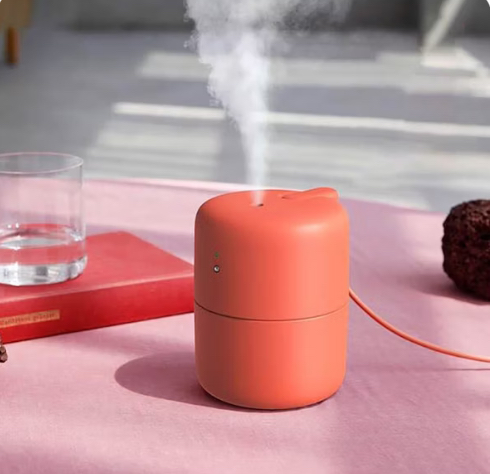In an era of hyperconnectivity and desk-bound productivity, the simplest devices often yield the most profound enhancements. The Minimal USB Desktop Humidifier is one such object—a quiet, often-overlooked instrument that has evolved from a wellness novelty to an essential fixture of the modern workspace. Compact, portable, and elegantly unobtrusive, this small device reflects a growing preference for clean aesthetics, personal climate control, and seamless integration into one’s daily digital routine.
Far more than just a moisture emitter, the modern USB humidifier has emerged as a hybrid of lifestyle, design, and health. Its rise parallels broader cultural shifts: toward mindful productivity, aesthetic minimalism, and the mix of utility with visual harmony. In this editorial, we examine the cultural relevance, design language, and lifestyle impact of the Minimal USB Desktop Humidifier—an object that quietly redefines the ambiance of contemporary living.
The Wellness Imperative: Why Moisture Matters
It’s easy to underestimate the importance of indoor humidity, particularly in environments dominated by central heating, artificial cooling, and long work hours in front of screens. Dry air is a subtle antagonist—it causes skin dehydration, sinus irritation, reduced focus, and even static electricity. Yet most of these discomforts remain unnoticed until their absence is felt.
Enter the desktop humidifier, a solution not just to physiological symptoms, but to overall mood and mental clarity. The simple act of adding moisture to the air can transform a sterile office into a breathable, more humane space. It’s no coincidence that these devices often appear beside potted plants, soft lighting, and sound machines—cornerstones of the contemporary wellness ecosystem.
Minimalist Design: Aesthetics in Functionality
The design of the Minimal USB Desktop Humidifier is rooted in the Scandinavian and Japanese philosophies of simplicity. With cylindrical or capsule-like forms, soft matte finishes, and muted tones such as fog white, pebble gray, or blush pink, these humidifiers blend seamlessly into any workspace without demanding attention. They are more sculpture than appliance.
Many incorporate soft-glow LED halos, ambient light rings, or capacitive-touch power buttons, reinforcing the idea that technology can be gentle, even meditative. The result is a product that doesn’t just sit on your desk—it belongs there, visually and emotionally. These forms support a broader trend toward “calm design,” where tools quietly assist rather than distract.
Portability and Power: USB as a Design Choice
The decision to adopt USB as the powering standard is as strategic as it is practical. It untethers the humidifier from cumbersome plugs or proprietary cables, allowing it to draw power from laptops, power banks, or USB hubs. This makes it ideal for workspaces that fluctuate between office desks, remote coffee shops, or home environments.
USB power also subtly reflects a new hierarchy of tools—one where small, ambient devices cohabit with digital productivity machines. The humidifier, by operating via USB, inserts itself effortlessly into the digital ecosystem without demanding its own infrastructure.
Sound, Steam, and Atmosphere
Beyond the visible mist, the sound of a good humidifier matters. The best USB desktop units emit a faint, near-silent hum or soft bubbling that’s often more calming than distracting. Combined with cool or warm mist, the output creates an ambiance akin to light rain or a forest stream—an artificial but welcome sensory intervention in typically sterile work environments.
Some advanced models even offer aromatherapy capabilities, allowing users to infuse essential oils into the water reservoir. This expands the device’s purpose beyond hydration into emotional modulation—using scent as a medium to enhance focus, reduce anxiety, or simulate natural environments.
Emotional Technology: The Return of Tactility
In the age of glass screens and virtual interfaces, the tactile nature of objects like humidifiers becomes increasingly valuable. Their physical presence—the way they glow, pulse, emit vapor, or invite a twist to open—adds an analog counterbalance to digital saturation. Users are not merely turning on a device; they are tending to a tool that reacts, softly and reliably, to their needs.
This reflects a movement toward emotional technology—products that not only perform but also feel considerate. Much like mechanical keyboards, analog notebooks, or stylized alarm clocks, the USB desktop humidifier provides a haptic grounding. It reminds users of the physical world, offering a micro-ritual within the efficiency-driven day.
The Intersection of Object and Space
A humidifier may seem like a minor addition to one’s environment, but its presence reshapes the spatial narrative. On a cluttered desk, it stands as an emblem of intentionality. In minimalist interiors, it offers organic movement and breath—literally. The slow dispersal of vapor adds motion to stillness, subtly animating corners of one’s home or office.
Designers increasingly consider humidifiers as part of the decor equation. Paired with low-profile speakers, ceramic mugs, or artfully arranged stationery, they form part of a visual language that says: this is a space for presence, not just performance. They do not dominate, but rather harmonize.
Sustainability, Materials, and Maintenance
Newer iterations of USB humidifiers also show increased attention to sustainability. Brands are moving away from glossy plastics and instead embracing recyclable or biodegradable materials, such as bamboo composites, matte silicone, or frosted PET. Water reservoirs are now designed to be easy to clean, reducing the risk of mold or bacterial growth—a common issue with earlier models.
Some companies go further, offering refillable cotton wicks, UV light sanitation features, or self-drying chambers. These features cater to an eco-conscious audience, aligning personal well-being with environmental mindfulness.
The Quiet Status Symbol
Interestingly, the Minimal USB Desktop Humidifier has evolved into a kind of quiet status symbol. It signals one’s attunement to detail, wellness, and aesthetics. Like a Muji pen or a glass carafe, it doesn’t scream luxury but whispers taste. It may not be expensive, but it speaks to discernment—the kind that defines taste cultures in design, tech, and personal care.
Its presence is especially notable on the desks of designers, freelancers, and digital creatives—those who cultivate spaces with care and intention. It says: “I value comfort as much as output.”
Small Object, Significant Shift
In the end, the Minimal USB Desktop Humidifier is less about the mist and more about what that mist represents—a move toward environments that nourish rather than deplete. In its whisper-quiet operation, ergonomic form, and seamless integration, it becomes a symbol of how the smallest devices can carry the greatest cultural resonance.
As work and life continue to blend, and as we spend more time tethered to devices in enclosed spaces, objects like these offer balance. They don’t just modify the air—they elevate the atmosphere.
No comments yet.








